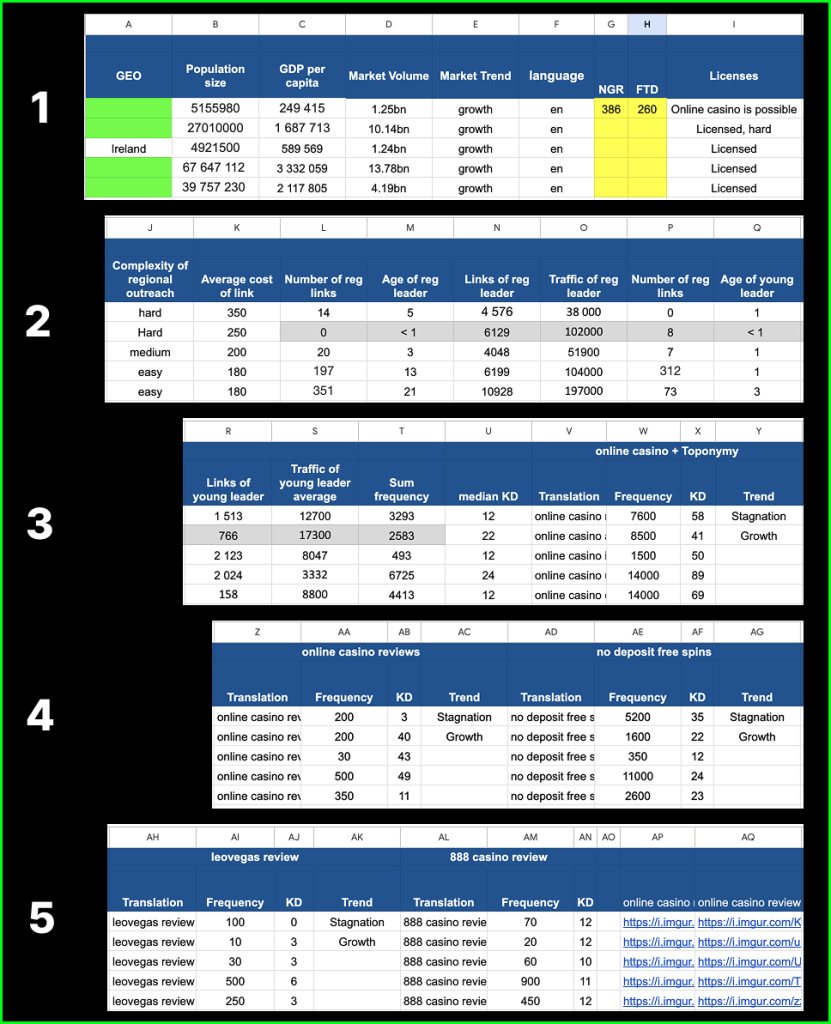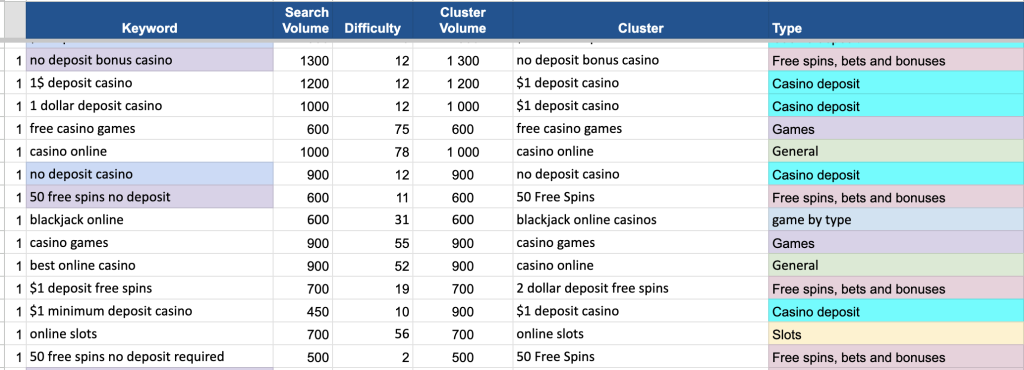SEO vs. Arbitrage: How we took a slot site to the top in 3 months

Due to a signed Non-Disclosure Agreement (NDA), this case study does not contain specific mentions of the client, brand, domain names, or any other information that could identify the customer. Some details have been modified or generalized.
- Niche: iGaming (slots)
- Implementation period: 3 months
- Main goal: Obtain deposits in a Tier-1 region
- Initial situation: The site had previously relied exclusively on arbitrage traffic through paid advertising.
- Task: Bring the site to the top of organic search results as quickly as possible and start generating deposits
Client Situation Overview
Slot sites are among the most challenging niches for SEO promotion in iGaming, especially when targeting Tier-1 regions. It’s not just about generating traffic—it’s about conversion, measured in deposits, where every visitor counts in dollars rather than clicks. Traffic alone without deposits is meaningless. The search results are often dominated by industry giants with years of history, massive budgets, and strong backlink profiles. On top of that, new competitors emerge daily with different strategies and resources. Any mistake at the start of an SEO campaign can mean wasted months and budgets that could have been spent on something more profitable.
The client came to us after a long period of working with an arbitrage team. Their primary focus had been on paid advertising, which was delivering results. However, they decided not to keep all their eggs in one basket and started diversifying traffic sources. SEO seemed like the logical next step—a more stable approach, less dependent on ad bans, and one that could potentially bring long-term revenue.
The client’s main objective was to generate deposits in a Tier-1 country within a short three-month timeframe. This was an ambitious deadline, and we knew that traditional SEO methods were unlikely to deliver results that quickly. Initially, the client envisioned a review site that compared slots, brands, and bonuses—similar to the industry leaders in search results. We had some doubts about this strategy, but we needed additional niche research by region to present the best approach.
From the outset, we warned the client that launching a review site and ranking it in such a competitive niche within three months would be extremely difficult. However, after conducting an in-depth analysis, we could propose a realistic strategy. We didn’t reject the project—in fact, we were intrigued by the challenge. But we agreed on one key condition: before starting any work, we would conduct a comprehensive analysis of the niche, GEOs, competitors, and possible site formats. Only after that would we finalize a realistic strategy that could deliver results within the given timeframe. The client agreed, and we moved on to the research phase.
Project kickoff and strategy development
The client did not have a clear idea of which GEO they wanted to target. Their only requirement was a Tier-1 country. From there, it was up to us to determine which market offered the best chances for profitability.
We didn’t limit ourselves to a few “popular” directions. Our final shortlist included 15 countries, such as the UK, Italy, New Zealand, Australia, Spain, Ireland, Belgium, and others. Each of these was analyzed with a structured approach, taking into account: macroeconomic indicators (e.g., GDP per capita), presence of a local gambling license, overall market state and industry trends, language of the country (and its SEO potential), population size, search competition, feasibility and complexity of regional outreach, market value in terms of potential monetization.

Initial GEO Analysis for the Client (we analyzed 44 key indicators across 15 countries.)
Additionally, we conducted an in-depth competitive analysis for each GEO, including domain research.

Competitive Landscape Analysis for Ireland (One of the 15 GEO analyses conducted.)

Domain Analysis for Ireland (One of the 15 GEO analyses conducted.)
At the same time, we examined the types of websites dominating search results: review sites, content-driven platforms, and standalone mono-slot sites. We studied various formats, assessed competitor growth rates, and projected visibility potential for medium- and high-volume queries. Given our tight timeframe, ranking for mid-volume keywords was not an option.
At this stage, one thing became clear: launching a review site was a strategic mistake given the project’s timeline. The competition among review sites in Tier-1 countries was extremely fierce. Many of them were well-established domains with thousands of backlinks, deep site structures, and strong PR support. Breaking into that space quickly was unrealistic.
We compiled all our data, created a report, prepared a presentation, and held several strategic sessions with the client. They shared their own insights—knowledge about competitors, traffic patterns, and behavioral specifics across different GEOs. This dialogue became the foundation for building a realistic and flexible strategy. Our goal wasn’t just to implement the client’s idea—it was to help them generate actual profit.
Respecting their vision, we proposed an approach that could truly deliver results within the given timeframe. Based on our calculations, the best option was a mono-slot website.
Once all details were agreed upon, we were ready to launch—with a clear strategy, the right GEO, and a plan to generate real deposits as quickly as possible.
Implementation of the strategy
Development
After the final approval of the strategy, we swiftly registered 10 domains with local extensions based on the chosen GEO. Each of these domains hosted a new website dedicated to a single slot game. The sites were not only similar in design and structure but also followed the same approach in navigation, page architecture, UX solutions, and technical aspects to identify the best-performing model in terms of ranking factors.
Content
For each website, we developed a comprehensive semantic core tailored to the local language specifics, search queries, and user expectations.

A segment of the semantic core collection for selected GEOs

A segment of competitor layout analysis
Based on this analysis, we created detailed content briefs for website content development. Unique texts were crafted, optimized for users by considering search intent, relevant SERP snippets, and competitive stylistics. Additionally, basic on-page optimization was implemented, including proper page structuring, meta tag optimization, load speed improvements, and mobile version enhancements. All these efforts contributed to better ranking performance in Google for the newly created sites.
Link Building
At the initial stage, each website received a minimal but well-planned number of backlinks. We worked with safe sources, focusing on natural anchor lists, donor site relevance, and regional targeting. The primary goal was to test the search engine’s initial reaction and gather insights into each domain’s potential without overloading them.
Analysis of initial results & selection of leaders
During the first two weeks, we monitored growth dynamics, indexing progress, keyword movements, behavioral signals, and early conversions. This allowed us to identify a few domains that demonstrated significantly higher growth rates. These top-performing sites were selected for further scaling, while the other projects were discontinued to concentrate resources where ROI was most promising.
In the selected projects, we doubled the scope of work: refined site structures, conducted A/B testing of layouts, added landing pages for various search queries, and intensified link-building efforts by significantly expanding backlink profiles. Simultaneously, we analyzed user behavior in-depth, including a detailed examination of conversion paths.
Challenges & Key Insights
- One of the crucial insights was that targeting mid-volume keywords was ineffective within a limited timeframe. Even reaching the TOP-10 did not guarantee traffic or, more importantly, conversions. The only way to generate deposits was by ranking in the TOP-3 for high-volume queries.
- Another key aspect in the slot niche was that search ranking alone wasn’t enough—snippet attractiveness also played a crucial role. Even with similar visibility, the site with a more aggressive title structure, rating display, and relevant formatting received more clicks.
- Additionally, certain GEOs with relatively low competition had outreach challenges. Therefore, it was essential to evaluate not only the GEO’s attractiveness but also the feasibility of operating within it.
Despite these challenges, they did not hinder our progress. Instead, they allowed us to quickly adapt the strategy, adjust our focus, and achieve initial results that directly impacted the primary goal—deposits.
Results
Our team successfully executed the core objective—within three months, we implemented an SEO strategy that not only propelled the site into the TOP-3 for high-volume queries but also generated the first real profits. The site started driving consistent traffic and, most importantly, became an alternative revenue stream for the client, independent of paid traffic sources.

The model fully met expectations: effective, scalable, low-risk, and yielding predictable results. The client was satisfied with both the execution speed and financial outcomes, leading to the decision to scale this strategy across new GEOs.
Conclusion
Arbitrage traffic can be an effective tool for user acquisition, but it does not guarantee stability or predictability in the long term. Relying solely on paid traffic creates substantial risks for a business. That’s why diversifying traffic sources is a critical condition for maintaining financial stability and long-term confidence.
In this context, SEO serves as a reliable alternative channel: it ensures a steady flow of organic users, is less vulnerable to external changes, and delivers sustainable results over time.
The execution of this project once again confirmed the effectiveness of our approach: we don’t just fulfill a request—we deeply analyze the situation to propose the most rational and results-driven solution. In some cases, this means moving away from the client’s initial idea in favor of a strategy that truly ensures business goal achievement.


